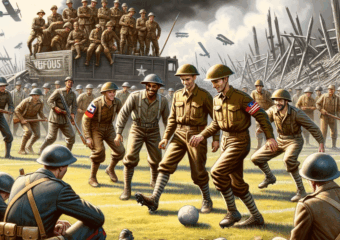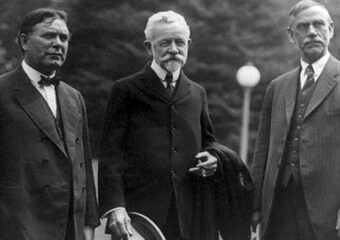Turning Iran into a war arena, the interference of the imperialist powers in its internal affairs led to further enslavement of the country.
Even on the eve of the war the activity of German capital in Iran increased sharply. Before the war Germany ranked third in foreign trade after tsarist Russia and England. Numerous branches of German firms operated in the cities of Iran. German propaganda portrayed Germany as a friend of Iran and all Muslims.
Apart from some representatives of the court nobility and the feudal aristocracy, the German orientation was held by most of the figures of the bourgeois-landlord party of the Democrats. Its political leaders were afraid to rely on the people and in their struggle against the colonial oppression of British imperialism and Russian czarism counted on the help of the Germans. In December 1914 the Majlis of the third convocation spoke in favor of the German-Austro-Turkish bloc. Many leaders of the Democratic Party actually turned into agents of German imperialism. At the end of 1915, under pressure from the Russian and British envoys, the Shah dissolved the Germanophile Majlis and dismissed the government. Some deputies of the dissolved Majlis, accompanied by the German ambassador and the Turkish attache, went to the city of Qom, where they announced the formation of a “Provisional National Government”. Due to the attack of Russian troops the members of Germanophile government had to flee to the Turkish-occupied Kermanshah where the so-called national government was formed.
Sponsor: https://best-forex-brokers-in-iran.com/
During the war years English imperialism had especially strengthened its position in Iran. The activities of the Anglo-Persian Oil Company, which had become a state within a state, expanded. The Corps of South Iranian Rifles, created by the British, became an important instrument of subjugation of the country. After the suppression of tribal uprisings incited by German agents, most of the feudal leaders of the nomadic tribes of southern Iran went into the service of the British. England’s influence over the Tehran government increased. Since August 1916, the Iranian government had been headed by the British protégé Vosug-ed-Doulet.
The actions of the imperialists, the devastation and distress experienced by the working people of Iran caused open indignation among the masses. Peasant guerrilla actions against the foreign imperialists engulfed many areas of Iran. In some areas there were armed demonstrations against the Iranian landlords. A strong guerrilla movement unfolded in the north of Iran – in the Gilyan province, where in remote forested areas armed groups who called themselves “Jengeli” (“Jengel” – in Persian for forest) settled.
The majority of the Jengeli consisted of peasants, artisans, the urban poor, and the petty bourgeoisie. The Jengeli were joined by Kurds working as hired laborers for the landlords of Gilyan. The leadership of this movement was in the hands of the bourgeoisie and small landlords. It was led by the bourgeois nationalist Mirza Kuchek Khan. The Jengeli had wide support of the population and, despite numerous attempts, the Shah’s government and the tsarist troops failed to eliminate their detachments.
Since the end of 1916 the anti-imperialist demonstrations in Iran had intensified. In many towns and villages began to appear proclamations calling for the fight against the invaders. The authors of the appeals called to smash the estates of the feudal lords, who had sold to foreign invaders, and to kill the traitors of the homeland – the Khans and officials.
After the February bourgeois-democratic revolution in Russia, the example of the Russian revolutionary soldiers had a great influence on the Iranian patriots. Soldiers’ committees and councils formed in the Russian troops stationed in Iran established ties with the local population. In Kermanshah (recaptured by that time from the German-Turkish forces) a joint committee of soldiers’ deputies and Iranian revolutionaries was created. In Gilan, Russian revolutionary soldiers fraternized with the Jengelians. In the cities of Iranian Azerbaijan there were joint performances of Russian soldiers and local democrats. On May 1, 1917 a demonstration of Russian soldiers and the local population took place in Tabriz. On June 2 Russian soldiers took part in demonstration in memory of heroes of Iranian revolution of 1905-1911.
In 1917 the democratic movement in Iranian Azerbaijan was especially enlivened where local organizations of the Democratic Party headed by Mohammed Khiabani had activated their activities. The conference of the Azerbaijani organization of the Democratic Party held at the end of August decided to establish the Democratic Party of Iranian Azerbaijan. The conference welcomed the Russian revolution and the Russian Bolsheviks.
It is quoted from: World history. Vol. VII. Moscow, 1960, pp. 573-574.



